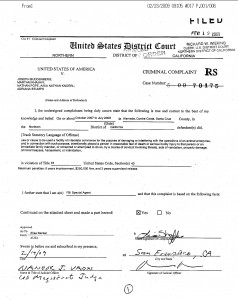The activists were arrested, in the very first use of this sweeping law, for activity like “chalking defamatory slogans,†creating fliers, protesting while wearing masks, and attending a protest where an alleged attempt at forced entry took place. I was hoping that the criminal complaint would reveal something, anything, to justify such serious “terrorism†charges.
Instead, it reveals how scarce anti-terrorism resources are being squandered on surveilling and investigating First Amendment activity.
Here are a few highlights:
- Video surveillance used to track activist leafleting. Fliers were left at Café Pergolesi in Santa Cruz that listed the names, addresses, and phone numbers of animal researchers. It included rhetoric like “animal abusers everywhere beware we know where you live we know where you work we will never back down until you end your abuse.†That kind of heated rhetoric has been used in the leaflets, posters, and chants of not just the animal rights movement, but every other social justice movement. It’s not pleasant, but it is protected First Amendment activity. FBI agent Shaffer says video surveillance was used to identify two activists who left the leaflets in the coffee shop.
- Internet records used to track activists researching public information. FBI agent Shaffer says two of the defendants used “a public internet terminal to download and access the personal information for researchers at the University of California Santa Cruz.†The public information appeared on a flier titled “Murderers and torturers alive & well in Santa Cruz July 2008 edition.†The government obtained internet records from the university, tracked them to a Kinko’s, and then used video footage and business records from Kinko’s to identify activists using the internet for this information.
- DNA testing used to match activists with bandanas allegedly worn at a protest. Agent Shaffer says “based on DNA comparisons, laboratory analysis confirmed that KHAJAVI’s DNA was on at least one bandana, and that a combination of POPE’s and STUMPO’s DNA was on another recovered bandana.†What’s striking is that the government says it doesn’t have the money to help states use DNA testing in death penalty cases—and exonerate innocent people on death row—but there is money for DNA testing of activists’ bandanas.
The only mention of actual criminal activity in the entire criminal complaint is when Shaffer describes an incident at a protest at the home of “Professor Number Eight.†The professor’s husband says he “heard loud banging on the glass pane on the door†and saw “the door handle being twisted back and forth.†He opened the door, yelled at activists, and struggled with someone, and then he says he was hit with a “dark, firm object.†He recorded a license plate number from a car at the protest and gave it to the police, and police linked the car to one of the defendants.
At the very worst—assuming we believe everything this researcher and the FBI are saying—that is obviously not First Amendment activity. But it’s critical to note that the FBI is not alleging that any of the defendants attempted a forced entry, or that any of the defendants struck this researcher. Read the complaint for yourself. The FBI argues that these activists were present at this protest, and that their presence makes them terrorists.
Let’s think about this guilt-by-association reasoning from another perspective. I was covering an antiwar protest a few years ago, and I was beaten by police while wearing my Congressional press credentials (a lawsuit was later settled out of court). I was attacked by a few cops, but there were many more at the protest. Let’s apply the same FBI logic to my personal experience: if DNA testing could link riot gear to cops who were at that protest, would the government hold all of them responsible for my attack?
Of course not. However, the Green Scare and the War on Terrorism thrive on double standards. A glaring example of the hypocrisy is on page four of this complaint. FBI agent Shaffer says activists chanted “murderer leave town, terrorist leave town†at a protest. Apparently, if the FBI calls activists “terrorists,” and if corporations call activists “terrorists,” and if politicians call activists “terrorists,” it’s just business as usual. But if animal rights activists turn the rhetoric on its head, and call a researcher a terrorist? It becomes evidence of “terrorism.â€
